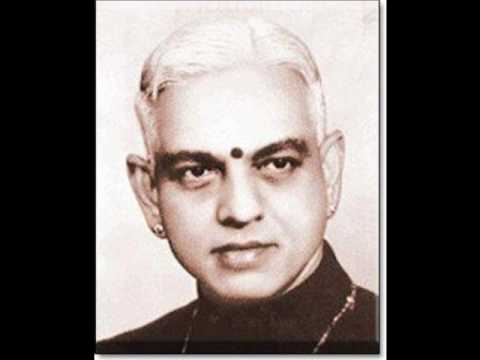| Home |
| Subscribe |
| Contact |
|
|

G.N. Baalasubramaniam - (1910-1965) It was a festival in the Kapaleeswarar temple, Mylapore, Madras. The top artiste to give the concert of the day did not turn up and the temple authorities were in a quandry. They decided upon the substitute and proceeded to meet G.V.Narayanaswamy Ayyar, Head Master, Hindu High School, Triplicane to depute his young son, Balasubramaniam to take the concert. Narayanaswamy Ayyar could not comprehend the request and was as confounded as Dasaratha was when sage Viswamitra wanted him to depute his son Rama. The authorities pointed out that Ariyakudi Ramanuja Ayyangar shot into fame only in similar circumstances by ascending the dias when the senior Vidwan Madurai Pushpavanam failed to turn up and had never an occassion to look back.
The parallel thrilled the ear of the father. He acceded and the son gave the concert, a memorable debut in which his guru Madurai Subramaniam and Pudukottai Vakil K.Rajamani accompanied on violin and mridangam. Fame and glory crowned G.N.Balasubramaniam quite soon even as the eastern sun in summer shoots into the sky and spreads its floodlight with dynamic speed and no twilight. Balasubramaniam was born on January 6, 1910 at Gudalur in Mayiladuthurai taluk. He studied in the Wesley College while learning music under his father, a disciple of Karur Chinnaswamy Ayyar and under Madurai Subramania Ayyar. He obtained his B.A. (Hons.) in 1929.
GNB, as he was popularly known, was a top vocalist of repute in a period which had seen fairly a large number of top-ranking musicians. His bracing, resonant and impressive voice and his special style rich with brisk brikas and pleasing delivery of kritis was a satisfying and thrilling experience to the vast concourse of admirers. His unique style, regulated tempo and masterly delivery were the delights of the audience. His melifluous voice would traverse the three octaves and the three 'kalas' with ease. His brikas were infectious and he kept his ears and mind open to receive what was best in other musicians. He had high respect for Ariyakudi Ramanuja Ayyangar, the senior artiste of eminence. He had a partiality for Todi, Kalyani and Kamboji and for Andolika, Nalinakanti, Vasantabairavi, Jothiswarupini, etc. His disciple, Trichur V.Ramachandran states that his master's style was essentially of a madhyamakala which sustained the interest of the audience. His command of ragalakshanas was amazing revealing the quintessence of the ragas at the very outset. His singing was crisp and 'sangatis' measured.
GNB was one of the prominent composers of recent decades. Out of his 250 compositions in sanskrit, Telugu and Tamil in traditional and his own invented ragas like Chandrahasita, Sivasakti, Amrita Behag, etc., sixty had been published. A gentleman with humility as he was, he would not sing his own compositions in concerts. His respect for values was prodigious. He would return the nominal honoraria he got from the Music Academy as donation. A further feature of his concerts was that he would review the performances of his accompanists and his own. His joy would be immense at the excellence of others. He had a soft heart for rising artistes. His anxiety to satisfy the susceptibilities of the audience was immense.
Even as a boy, he had taken part in musical and dramatic activities in the Hindu High School which he joined in the sixth standard. Later he took the lead role of Dushyant in the famous Tamil film 'Sakuntala' in which another great musician, M.S.Subbulakshmi was the heroine. He had played the role of 'Narada' in the films Bhama Vijayam and Sathi Anasuya. Udayanan, Vasavadatha is another film in which he had acted. He was also pleased with the rendition of Ustad Bade Ghulam Ali Khan that he became an ardent devotee of Khan.
Mudra:
Compositions:
- aDagalEni anni - varALi
- ambOruha pAdamE (tv) - ranjani
- bhAramA I bAluni - hamsanAda
- dasha shata daLa - hamsanAda
- dhIm tadhIm tanana - hamsAnandi
- en manattAmarai - rItigauLa
- enta ninnu - candrahasita
- entO moraliDa lEdA - kannaDa
- eppuDu nI - bhairavi
- gati vErevarammA - bhairavi
- inkevarunnAru - shubhapantuvarALi
- inta parAku nIvE - bhairavi
- kamala vAsini (tv) - gAvati
- kamalAsini sundari - kalyANi
- kAraNamEmi kAnanE - AndOlikA
- karimukha varadA - nATa
- karuNa jUDa rAdA - shahAnA
- karuNinci kApADuDa (tv) - yadukulakAmbhOji
- madhurApuri kalyANi - pUrvikalyANi
- mahA tripurasundari - kAmbhOji
- mahAdEva manOranjani - ranjani
- manam irangAda - ravicandrikA
- manasArakanE nammaka - AbhOgi
- manasu rAdA - sAmakAdambari
- mAnavakula bhUSaNa - hindOLa
- mAnavatI nannu sadA - tODi
- mangaLa varadAyaki - kadanakutUhala
- mArakOTi sundari - bahudAri
- nA moralanu - nArAyaNi
- nAkabhaya varamosagi - nATakuranji
- nannu brOva nI - cencukAmbhOji
- nI allAl ini - kAnaDA
- nI caraNambujamunu - kIravANi
- nI daya galgunO - SaNmukhapriyA
- nI pAdamE gati naLinakAntimati - naLinakAnti
- nI samAnamevaru - shubhapantuvarALi
- ninnu vinA vErE gati - rItigauLa
- ninnu vinA vErevaru - mALavi
- niratamugA ninnE - udayaravicandrikA
- niravadhi sukha dAyaki - malayamAruta
- nIvalayincE - chAyAranjani
- nIvE nannu (varNa) - ranjani
- pAda bhajana - khamAs
- paramakrpA sAgari - yadukulakAmbhOji
- parAmukhamEla namma - kAnaDA
- paritApamulEka - SaNmukhapriyA
- sadA ninnE - naTabhairavi
- sadA pAlaya - mOhana
- sakala kalA vANi (varNa) - hindOLa
- sAmagAna lOlE - hindOLa
- samAna rahitE - sArangatarangiNi
- sArasAkSi sadA (tv) - varALi
- sarasijAkSi nI - mArgahindOLa
- shankara mahAdEva - dEvamanOhari
- sharatcandra - vINAdhari
- shivAnanda kAmavardhani - kAmavardhini
- shrI cakrarAja nilayE - shivashakti
- sujana mAnasa - hamsAnandi
- tAmasamika tALanu - AbhOgi
- taramu gAdamma - pUrvikalyANi
- vadarEramma nI pAda - sAvEri
- vara vallabha ramaNa - hamsadhvani
- vinuta pAlini - shivashakti

